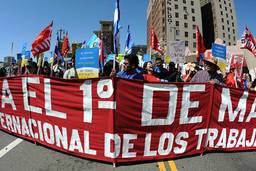On July 13, Adbusters posted on its website, “On September 17, we want to see 20,000 people flood into lower Manhattan, set up tents, kitchens, peaceful barricades and occupy Wall Street for a few months.”
Their plan? To reclaim public space and speak out against corporate control of government.
Inspired by the “shift in revolutionary tactics” promulgated by this year’s protest movements in Egypt and, more recently, in Spain, Adbusters and several affinity groups have organized an occupation in the heart of the financial world. Or in the heart of America’s “financial Gomorrah,” as the organizers like to call it.
The planned occupation has emerged as a leaderless movement, fueled by public anger at the financial world’s impunity and its unprecedented levels of influence in government.
When the New York affiliate for CBS asked citizen volunteer Bill Csapo if he was an official spokesperson for the online group Occupy Wall Street, he answered with a laugh: “Not any more than any of us are.”
Popular movements for social change this year in Cairo and Madrid followed similar organizational strategies, in which protestors congregated in central, public spaces (see video of Tahrir Square and Puerto del Sol, respectively) and set up tent cities. Demonstrating a potent brand of grass-roots democracy, protestors in these liberated zones formed citizen’s committees that undertook varying responsibilities such as cleaning and cooking, resolution drafting and watch duty.
Following Adbusters’ July announcement for a similar movement in Manhattan, notable groups and individuals have jumped on board. Hactivist group Anonymous has announced its support, and musician Lupe Fiasco has extended his hand to the cause, offering to donate fifty tents.
Sister occupations have been set for San Francisco, London, Madrid, Sydney, Milan, and Stuttgart, signifying that social activists the world over are taken with the idea.
The activists behind Occupy Wall Street hope to emulate the success of Tahrir Square, which was an integral force in the dethroning of former Egyptian President Hosni Mubarak last February. In Cairo’s case, the occupied square became the most compelling symbol of the country’s spontaneous rebellion against its autocratic leader.
By endowing Wall Street with a similar, populist significance, American activists may succeed in producing a symbolic rallying point to push their agenda for finance and government reform, especially as the nation has recently seen the first ravages of the Citizens United ruling and the appalling leniency granted to speculators and profit hounds responsible for the financial crisis.
However, there are significant differences between the situation that Egypt faced at the onset of its occupation of Tahrir Square and where the United States is now. Former Egyptian President Hosni Mubarak was an aggressive tyrant. The Egyptian people thus had an enemy against whom a diverse array of individuals with different political, social, and religious affiliations could organize.
The U.S. activists behind Occupy Wall Street inhabit an altogether different environment. The financial world lacks the identifiable characteristics of a single dictator, and it operates more as an abstraction compared to Mubarak’s concrete and oppressive security apparatus.
Additionally, the movement’s cri de guerre is far from codified. Its demands are all variations of politico-corporate reform, yet they still vary, ranging from the modest goal of a implementing a Federally appointed oversight committee to the more radical call for a one dollar, one citizen, one vote system in which only citizens could make campaign donations exceeding no more than $1.
Nevertheless, perhaps the absence of a single, unifying message (or a ubiquitous tyrant to rally against) will bare little on the Wall Street occupation’s outcome. For example, Spain’s activists (called Indignados, or “the indignant”) did not arise from a single issue or cataclysmic event, but rather from the general disarray of their nation’s economic and political institutions. It was a popular spirit of change—propelled by the creative and moral bankruptcy of an ineffective system—that brought them out into the streets.
And while the Indignados have yet to secure much attention from the ruling elite other than baton-wielding riot police, their collective energy may still generate powerful social change. As Pablo Ouziel at Truthout reports, people’s assemblies organized by activists in Madrid’s tent cities have worked collectively on a number of issues: Interceding for families in risk of eviction from their repossessed homes, attempting to halt the closure of public hospitals threatened by austerity measures, and protecting immigrants in poor districts from police violence.
So, if Occupy Wall Street’s demands for an overhaul of campaign financing and state corporatism fail, its participants should take cues from their Spanish peers. Once a public space is liberated, activists within it can spawn new and experimental modes of communal organization. The space liberated in lower Manhattan on September 17 may be perfect for doing precisely that.
Patrick Glennon is a writer and musician living in Chicago. He received his B.A. in History from Skidmore College and currently works as Communications Manager for the Michael Forti for Cook County Court campaign and as the web intern at In These Times.



